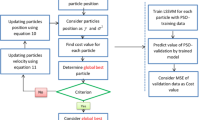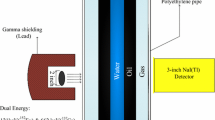Abstract
Carbon dioxide injection is a known promising and economical technology for improving oil recovery. Despite its immense effect on oil recovery, the application of this technique in modern recovery industry has been limited due to poor solubility of n-alkanes in supercritical CO2. Therefore, it is very consequential to investigate the solubility of different n-alkanes in supercritical CO2. Since experimental methods for measuring the solubility of n-alkanes in supercritical CO2 at different temperatures and pressures are not economical and usually take a long time, feasibility of applying intelligent tools in the solubility prediction of different n-alkanes in supercritical CO2 at pressures up to 45.9 MPa was conducted in this study. For this purpose, two models including an artificial neural network and an adaptive neuro-fuzzy interference system (ANFIS) both trained with particle swarm optimization (PSO) algorithm were used for simulating this process. Calculated mole fractions of n-alkanes in supercritical CO2 from ANFIS–PSO model were excellently consistent with actual measured values. Moreover, comparison between these models and Chrastil semiempirical correlation show superiority and accuracy of the proposed ANFIS–PSO approach. Results of this study indicate that ANFIS–PSO method is a powerful technique for predicting solubility of n-alkanes in supercritical CO2.







Similar content being viewed by others
References
Cao M, Gu Y (2013) Physicochemical characterization of produced oils and gases in immiscible and miscible CO2 flooding processes. Energy Fuels 27:440–453
Abedini A, Torabi F (2014) Oil recovery performance of immiscible and miscible CO2 huff-and-puff processes. Energy Fuels 28:774–784
Zhang P, Yang HJ, Xu L (2013) Solubilities and partial molar volumes of new CO2-philic propane derivatives in supercritical carbon dioxide. J Chem Thermodyn 67:234–240
Hemmati-Sarapardeh A, Ayatollahi S, Ghazanfari MH, Masihi M (2014) Experimental determination of interfacial tension and miscibility of the CO2–crude oil system; temperature, pressure, and composition effects. J Chem Eng Data 59:61–69
Cao M, Gu Y (2013) Oil recovery mechanisms and asphaltene precipitation phenomenon in immiscible and miscible CO2 flooding processes. Fuel 109:157–166
Luo P, Zhang Y, Wang X, Huang S (2012) Propane-enriched CO2 immiscible flooding for improved heavy oil recovery. Energy Fuels 26:2124–2135
Ren W, Scurto AM (2007) High-pressure phase equilibria with compressed gases. Rev Sci Instrum 78:125104
Gardeler H, Fischer K, Gmehling J (2002) Experimental determination of vapor–liquid equilibrium data for asymmetric systems. Ind Eng Chem Res 41:1051–1056
Yu J, Wang S, Tian Y (2006) Experimental determination and calculation of thermodynamic properties of CO2+ octane to high temperatures and high pressures. Fluid Phase Equilib 246:6–14
Eustaquio-Rincon R, Trejo A (2001) Solubility of n-octadecane in supercritical carbon dioxide at 310, 313, 333, and 353 K, in the range 10–20 MPa. Fluid Phase Equilib 185:231–239
Choi EJ, Yeo SD (1998) Critical properties for carbon dioxide+ n-alkane mixtures using a variable-volume view cell. J Chem Eng Data 43:714–716
Yang Z, Li M, Peng B, Lin M, Dong Z (2012) Dispersion property of CO2 in oil. 1. Volume expansion of CO2+ alkane at near critical and supercritical condition of CO2. J Chem Eng Data 57:882–889
Chandler K, Pouillot FLL, Eckert CA (1996) Phase equilibria of alkanes in natural gas systems. 3. Alkanes in carbon dioxide. J Chem Eng Data 41:6–10
Shi Q, Jing L, Qiao W (2015) Solubility of n-alkanes in supercritical CO2 at diverse temperature and pressure. J CO2 Util 9:29–38
Wang B, He J, Sun D, Zhang R, Han B (2006) Solubility of chlorobutane, ethyl methacrylate and trifluoroethyl acrylate in supercritical carbon dioxide. Fluid Phase Equilib 239:63–68
Furuya T, Teja AS (2004) The solubility of high molecular weight n-alkanes in supercritical carbon dioxide at pressures up to 50 MPa. J Supercrit Fluid 29(3):231–236
Peters CJ, Arons JDS, Harvey AH, Sengers JMHL (1989) On the relationship between the carbon-number of n-paraffins and their solubility in supercritical solvents. Fluid Phase Equilib 52:389
Sujit Kumar J, Giridhar M (2012) Modeling the solubilities of high molecular weight n-alkanes in supercritical carbon dioxide. Indian Institute of Science, Bangalore
Chrastil J (1982) Solubility of solids and liquids in supercritical gases. J Phys Chem 86:3016–3022
Gordillo MD, Blanco MA, Molero A, de la Martinez O (1999) Solubility of the antibiotic Penicillin G in supercritical carbon dioxide. J Supercrit Fluids 15:183–189
Sung HD, Shim JJ (1999) Solubility of C. I. disperse red 60 and C. I. disperse blue 60 in supercritical carbon dioxide. J Chem Eng Data 44:985–989
Keshmiri K, Vatanara A, Yamini Y (2014) Development and evaluation of a new semi-empirical model for correlation of drug solubility in supercritical CO2. Fluid Phase Equilib 363:18–26
Bose NK, Liang P (1996) Neural network fundamentals with graphs, algorithms and applications, 2nd edn. McGraw-Hill, Boston
deSouto MCP, Yamazaki A, Ludernir TB (2002) Optimization of neural network weights and architecture for odor recognition using simulated annealing. In: Proceedings of the 2002 international joint conference on neural networks, vol 1, pp 547–552
Lin ML, Chen CW (2010) Application of fuzzy models for the monitoring of ecologically sensitive ecosystems in a dynamic semi-arid landscape from satellite imagery. Eng Comput 27:5–19
Mahmoudabadi H, Izadi M, Menhaj MB (2009) A hybrid method for grade estimation using genetic algorithm and neural networks. Comput Geosci 13:91–101
Tahmasebi P, Hezarkhani A, Sahimi M (2012) Multiple-point geostatistical modeling based on the cross-correlation functions. Comput Geosci 16(3):779–797
Daryasafar A, Ganji Azad E, Ghahfarokhi AK, Mousavi SF (2014) Simulation studies on growth and death of microorganisms using the oil-degrading bacteria Petrotoga sp. Chem Eng Technol. doi:10.1002/ceat.201400129
Samanta B, Bandopadhyay S, Ganguli R (2004) Data segmentation and genetic algorithms for sparse data division in Nome placer gold grade estimation using neural network and geostatistics. Min Explor Geol 11(1–4):69–76
Zadeh LA (1965) Fuzzy sets. Inf Control 8:338
Ghafoori MR, Roostaeian M, Sajjadian VA (2008) A state-of-art permeability modeling using fuzzy logic in a heterogeneous carbonate (An Iranian Carbonate Reservoir Case Study). IPTC 12019 presented at the International Petroleum Technology Conference held in Kuala Lumpur, Malaysia (2008)
Vasant P, Elamvazuthi I, Webb JF (2010) Fuzzy technique for optimization of objective function with uncertain resource variables and technological coefficients. Int J Model Simul Sci Comput 3:349–367
Jang JSR (1993) ANFIS: adaptive-network-based fuzzy inference system. IEEE Trans Syst Man Cybern 23(3):665–685
Daryasafar A, Ahadi A, Kharrat R (2014) Modeling of steam distillation mechanism during steam injection process using artificial intelligence. Sci World J, 2014, Article ID 246589, pp 4
Kennedy J, Eberhart RC (1995) Particle swarm optimization. In: Proceedings of IEEE international conference on neural networks, vol IV. IEEE Service Center, Piscataway, pp 1942–1948
Author information
Authors and Affiliations
Corresponding author
Rights and permissions
About this article
Cite this article
Daryasafar, A., Daryasafar, N., Madani, M. et al. Connectionist approaches for solubility prediction of n-alkanes in supercritical carbon dioxide. Neural Comput & Applic 29, 295–305 (2018). https://doi.org/10.1007/s00521-016-2793-7
Received:
Accepted:
Published:
Issue Date:
DOI: https://doi.org/10.1007/s00521-016-2793-7




